
Chinese Soapstone Carved Luohan Figure, 14 cm Wide, 10.5 cm
A Chinese soapstone carved figure of Luohan, 14 cm wide, 10.5 cm high

Qing Dynasty Chinese Jadeite Plaque with Luohan and Dragon
A Chinese jadeite plaque, Qing Dynasty, 19TH/Early 20th century, one side carved with a luohan and a dragon, the other side is carved with a poem followed by the signature Zigang. With a fitted box. /, 6.5 x 4.3 cm

Chinese Carved Walnut Luohans, Dragon, Tiger, Ivory Lady Figure
A Chinese eighteen Luohans carved walnut and a figure, the walnut shell intricately carved with 18 Luohans in various pursuit, a dragon and a tiger, on a small wooden stand, boxed; together with a small Chinese carved ivory figure of a lady holding a ruyi…

Chinese Bronze Figure of Xianglong Luohan with Tamed Dragon
A Chinese bronze figure of Xianglong Luohan, 20th century the cast figure of Xianglong Luohan, also known as the 'Taming dragon Arhat', standing in long robes over the body of a tamed and submissive dragon, its head emerging from the cloud base, with a…
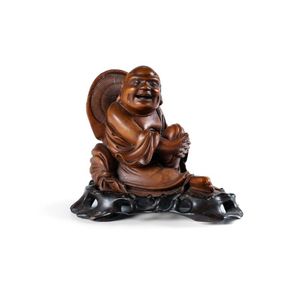
Qing Dynasty Boxwood Luohan Figure on Hardwood Stand (13cm)
Chinese carved boxwood figure of a Luohan, on a fitted hardwood stand. Qing Dynasty, length 13 cm

Qing Dynasty Lacquer Screen with Luohan and Ducks
A Chinese Eight-Fold coromandel lacquer screen; Qing Dynasty (1644-1912), 19th century; depicting a gathering of luohan in a garden within an archaistic border to one side, and to the reverse, a pair of mandaring ducks sitting on a garden rock next to a…

Chinese Soapstone Luohan Figure with Semi-Precious Stones Inlaid
A large Chinese soapstone figure of Luohan, Qing Dynasty (1644-1912) with semi-precious stones inlaind., 16.8 cm high
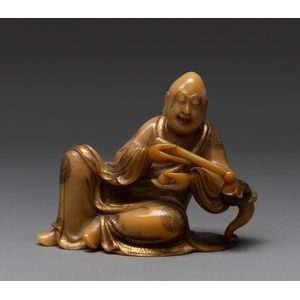
Qing Dynasty Soapstone Luohan Figure
A Chinese soapstone figure of Luohan, Qing Dynasty (1644-1912), 12 cm wide; 10 cm high

Qing Dynasty Chinese Soapstone Luohan Figure, 9.5cm
A Chinese soapstone figure of Luohan, Qing Dynasty (1644-1912), 9.5 cm high
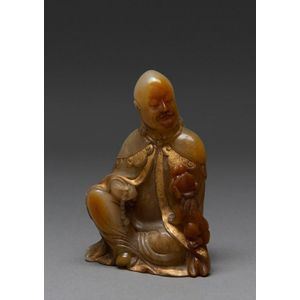
Chinese Qing Dynasty Soapstone Luohan Figure, 10.5 cm
A Chinese soapstone figure of Luohan, Qing Dynasty (1644-1912), 10.5 cm high
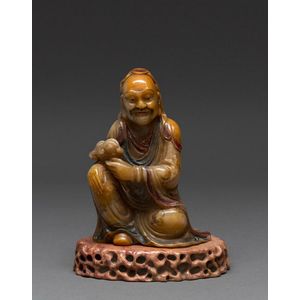
Chinese Qing Dynasty Soapstone Luohan Figure
A Chinese soapstone figure of Luohan, Qing Dynasty (1644-1912), 12 cm high

Qing Dynasty Chinese Soapstone Luohan Figure
A Chinese soapstone figure of Luohan, Qing Dynasty (1644-1912), 10 cm high

Serene Luohan Soapstone Carving
A Chinese soapstone carving of a Luohan, the serene ascetic seated cross-legged holding an alms bowl. Height 13.5 cm

Ming Dynasty Luohan Painting
A Chinese painting of a Luohan, Anonymous, Ming Dynasty (1368-1644) Luohan, ink and colour on paper. ', 66.4 x 35.9 cm. Provenance: Suzy Lebasi, Soo Tze Oriental Antiques, Melbourne, Australia. A private collection, Tasmania, Australia. Suzy Lebasi, Soo…

Qing Dynasty Soapstone Luohan Figure
A soapstone figure of a Luohan, Qing Dynasty (1644-1912) finely carved with a luohan dressed in loose fitting robes decorated with 'Shou' longevity roundels, the edge of the robe painted in gold pigment. His right hand is holding his long eyebrows,…

Qing Dynasty Luohan Figure
A soapstone figure of a Luohan, Qing Dynasty (1644-1912) finely carved with a luohan dressed in loose fitting robes, sitting on a rock base, with eyes wide open and left index finger pointing to the sky, 14 cm high. Provenance: a private collection, NSW,…

Luohan Carved Walnut Prayer Beads - 180cm Length
Chinese walnut shell prayer beads carved with Luohan monks, length 180 cm

Qing Dynasty Soapstone Luohan Figure
A Chinese soapstone carved figure of a Luohan, Qing Dynasty (1644-1913) the finely carved figure with a serene expression dressed in loose fitting red and orange robes, the hem decorated with scrolling lotus, the hands are holding a bowl under a small…
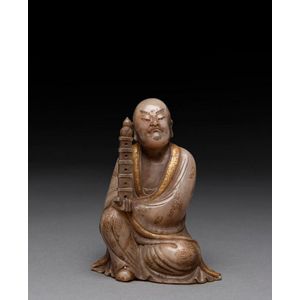
Qing Dynasty Chinese Soapstone Luohan Figure
A Chinese soapstone carved figure of a Luohan, Qing Dynasty (1644-1913) the finely carved seated figure dressed in loose fitting robes, the hem is decorated with scrolling lotus and gold pigment, is holding a pagoda on his right hand. 9.5 cm high.…
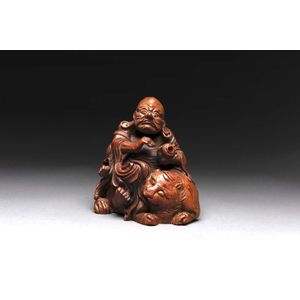
Qing Dynasty Bamboo Luohan Riding Tiger Statue
A Chinese bamboo carved figure of a Luohan, Fuhu, Qing Dynasty (1644-1912) it is carved with a luohan sitting on top of a recumbent tiger. 13.2 cm high
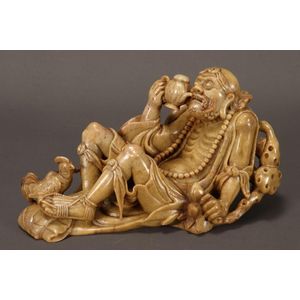
Emaciated Luohan Buddha with Teapot
Chinese carved stone figure, depicted an emaciated Luohan buddha, with ribs exposed and holding a teapot to mouth, in tones of brown, height 14 cm and length 26 cm

Qing Dynasty Celadon Jade Luohan Bracelet with Box
A celadon jade 'luohan' bracelet, Qing dynasty and box, jade luohan approx. 2.0 cm long each, the necklace fully extended 20.5 cm long. Provenance: C. C. Teng & Co., Taipei, 1 Oct 1996, no. 002776 (label and receipt, NTD180,000, approx US$6,480)

Traditional Chinese Luohan Chuang Couch-Bed
A Chinese traditional couch-bed (Luohan Chuang), height 84 cm, 20.8 x 114 cm

Carved Soapstone Luohan Figure with Buddhist Lion
A carved soapstone figure of a Luohan, 19th/20th century carved from a caramel coloured stone, the jovial figure seated holding a Buddhist lion in his hands, wearing a long flowing robe with incised decoration, his face with mouth open in laughing…

Jade Luohan and Tiger Figure
A Chinese jade figure of a luohan and tiger, representing B?ntoulu Z?nzh' (Taming Tiger arhat) the figure sits holding a pearl with a tiger climbing from the folds of his robe. Well carved in mushroom and yellow toned jade, height 7 cm

Set of 18 Carved Ivory Luohans
An impressive set of eighteen carved ivory Luohans, 19th/20th century, each bald ascetic finely carved standing wearing long layered wide-sleeved robes, in different postures and making different gestures with their hands and holding various attributes,…

Seated Luohan with Buddhist Lion, Soapstone Figurine
A soapstone figure of a seated Luohan, 19th/20th century, reclining with his left hand resting on the Buddhist lion crouched to one side, wearing loose robes with incised and gilt borders, the separate stand with simulated rockwork border, figure 6 cm,…

Seated Luohan with Buddhist Lion Sculpture
A soapstone figure of a seated Luohan, 19th/20th century, reclining enveloped in his loose robes on a base of scrolling clouds, holding his Buddhist lion crouched to one side, the face carved with lowered gaze, moustache and thick curly beard, the pale…

Tiger-Taming Luohan: Chinese Soapstone Carving
A Chinese soapstone carving of a Luohan seated on a tiger, holding a ruyi in his left hand & floating on a cloud, 20th century, wearing a robe with turquoise & coral coloured beads, with gilt trim on the edge, he was known as the Tamer of the tiger, on a…

Qing Dynasty Soapstone Luohan Figure with Gilded Stand
A carved soapstone figure of a seated Luohan Qing dynasty, 19th century, reclining with his left elbow resting on a small stand and his hand supporting his shaven head, wearing a loosely draped wide sleeved robe beneath a cloak tied at the neck, the…

Antique Chinese Soapstone Luohan & Lion Carving
Fine antique Chinese carved soapstone model of a Luohan and lion on fitted hardwood stand, early 20th century. Length of carving 18 cm. Chinese character script artist mark incised to base, together with previous owners identification

Large Cloisonne Vases with Buddhist Subjects
A mirror pair of very large cloisonne vases with Buddhist subjects. Chinese pair of very large mirror image cloisonne baluster vases on custom wooden stands. The body of the vases has depictions of the eighteen disciples of the Buddha (Luohans) who are…

Rare Luohan Head with Ming Dynasty Bank Note
A large Chinese wooden head of a Luohan, Jin/Yuan Dynasty 13-14th century, the expressive features very well defined, with original textile base attached to the surface, gesso and lacquer absent, consecration material found inside the head cavity, in the…
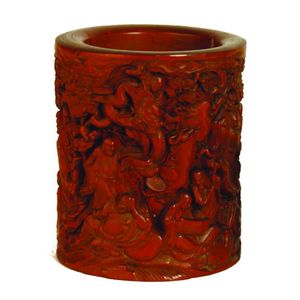
Chinese Boxwood Brush Pot with Eighteen Luohan Carvings
A Chinese boxwood brush pot with heavily carved decoration, the encircling scene depicts the 'Eighteen Luohan', the disciples of Buddha. Height 13.5 cm

Qu Yueshan Tortoise-Shell Snuff Bottle
A tortoise-shell snuff bottle, one side incised with a Luohan, the other side with a calligraphy poem, signed and sealed by Qu Yueshan (1933-), 7.5 cm high

Chinese Seated Luohan Wood Carving
A Chinese carved wood figure of a seated luohan, with lacquered surfaces with remnants of gilt. 14 cm

Ming/Qing Chinese Seated Luohan Figure
A large Chinese seated figure of a Luohan, finely carved, Ming/Qing dynasty, crossed legs with folds of the robe draping beyond, traces of linen under the worn lacquer, condition: Hands possibly replaced. Height 166 cm. Width 74 cm

Qing Dynasty Soapstone Luohan with Buddhist Lion
A carved soapstone figure of a Luohan Qing dynasty, 19th century reclining and holding a Buddhist lion licking his left earlobe, wearing loosely draped robes with incised motifs showing traces of polychrome decoration, his head turned to the front with…

Qing Dynasty Bodhi-Leaf Luohan Paintings with Sutra
Two framed Chinese Bodhi-leaf paintings of Luohan, Anonymous, Qing dynasty from an album of 30 leaves portraying 500 lohans, verso with Sutra written in gold ink, 17 cm x 24 cm (2). Provenance: Private collection New Zealand Note: An album possibly…

Kangxi Luohan Bowls
Chinese blue & white pair of 'Luohans' bowls, each bowl decorated with eight luohans, four character Kangxi mark to base. Dimensions 9.4 x 3.6 cm

Qing Dynasty Soapstone Luohan Figure with Stand
A carved soapstone figure of a Luohan and stand Qing dynasty, 18th/19th century, seated with hands clasped around his raised left knee, wearing loosely draped robes with an incised border and foliate motifs, the shaven head with benign expression, the…

Qing Dynasty Soapstone Luohan Figure with Alms Bowl
A soapstone figure of a Luohan Qing dynasty, 19th century, seated with right hand resting on his raised right knee, holding an alms bowl in his left, wearing loose robes with incised decoration picked out in black, the pale stone with some russet…

Qing Dynasty Soapstone Luohan Figure with Pagoda
A soapstone figure of a Luohan Qing Dynasty, 19th century seated holding a tiered pagoda in both hands, wearing a loosely draped wide-sleeved robe with incised borders and cloud scrolls, his shaven head with well defined features in downward gaze, carved…

Celadon Luohan Figure, Qing Dynasty
A soapstone figure of a Luohan Qing Dynasty, 18th/19th century seated holding a scroll in his right hand resting on his raised right knee, wearing long wide-sleeved robes clasped at the left shoulder, his face with downward gaze and benign expression,…

Qing Dynasty Luohan with Bodhisattva Inside
A gilt bronze figure of a Luohan, Qing Dynasty standing on a lotus pedestal, wearing a long wide sleeved robe revealing his bare torso, his hands pulling his skin apart to reveal a seated figure of a BodhisatTVa within, his face with laughing expression…

19th/20th Century Soapstone Luohan Carving
A soapstone carving of a Luohan, 19th/20th century the ascetic seated with his legs extended to the side and arms resting on a rocky ledge, wearing loosely draped robes with incised borders and cloud motifs, his shaved head raised gazing forward with…
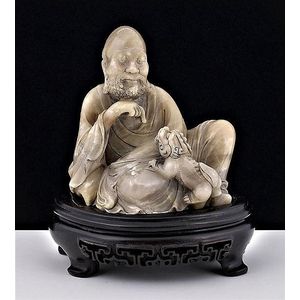
Qing Dynasty Soapstone Figure of Luohan with Lion
A soapstone figure of a Luohan with lion, Qing Dynasty, 19th century the bearded man seated with left knee raised, wrapped in long robes falling over a double gourd beneath his right arm, his right hand raised beneath his chin, as he gazes down at the…

Carved Soapstone Luohan Figure with Stand
A carved soapstone figure of Luohan and stand, late Qing Dynasty seated wearing loosely draped robes with incised decoration, his right arm resting on his raised right knee as he inserts a long prick into his ear, his face with smiling expression, the…

Qing Dynasty Luohan Soapstone Figure with Buddhist Lion
A soapstone figure of a Luohan, Qing Dynasty, late 18th/19th century seated with smiling expression and wearing loosely draped robes, his left knee raised and supporting a Buddhist lion held in his left hand, its forepaws resting on his shoulder and…

Chinese Carved Soapstone Seated Arhat Sculpture
A Chinese carved soapstone seated Arhat, luohan, the stone of red and green composition, the Arhat wearing long flowing robe, holding a scroll in both hands, the oval base supported on four short feet, 8.9 cm high (Arhat)

 Loading more...
Loading more...